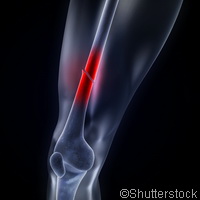Scientists uncover link between genes and bone disease
An international team of researchers has discovered 32 previously unidentified genetic regions linked with osteoporosis and fracture. Presented in the journal Nature Genetics, the study identified that variations in the deoxyribonucleic acid (DNA) sequences in these regions confer either risk or protection from the disease that weakens bone. Most regions encode proteins involved in pathways that concern the health of bone. The study was funded in part by the GEFOS ('Genetic factors for osteoporosis') project, which has received almost EUR 3 million under the Health Theme of the EU's Seventh Framework Programme (FP7). Osteoporosis is generated from the combined contributions of dozens, if not hundreds, of genes, according to the researchers. The findings also point to potential new methods for development of anti-osteoporosis treatments. 'We're learning that the genetic architecture of disease is very complex,' said Dr John Ioannidis from the Stanford Prevention Research Center in the United States, one of the authors of the study. In their meta-analysis, the researchers also identified six regions strongly associated with risk of fractures of the lower back or the femur. A total of 17 genome-wide association studies, 180 researchers and over 100 000 subjects were part of the meta-analysis. The researchers discovered that variants in 56 regions of the genome affect the bone mineral density (BMD) of individuals, of which 14 contribute to raising bone fracture risk. 'Even though bone mineral density (BMD) has an imperfect relation with fracture risk (i.e. about 50% of individuals without osteoporosis as diagnosed by dual-energy X-ray absorptiometry (DXA), however, still suffer fractures), our genetic study on BMD has allowed an unprecedented leap in sheer number of discoveries on human skeletal biology,' said Professor Fernando Rivadeneira from Erasmus Medical Center in the Netherlands and lead senior author on the study. 'We have now pinpointed many factors in critical molecular pathways which are candidates for therapeutic applications.' The study suggests that various pathways involved in bone health play a predictive role for osteoporosis. Body weight, build and gender are the most commonly used factors for predicting this disorder. 'The real power of our study lies in the ability to generate prospectively a huge combined data set and analyse it as a single study,' said Dr Ioannidis. 'It's likely that our expectations have been too high in terms of what single studies can accomplish. Each one of the many teams identified at most only one or two markers; many found none.' Further research is required to identify genes that contribute to disease. 'In reality, there may be 500 or more gene variants regulating osteoporosis,' said Dr Ioannidis. 'To find all of them, we'll need to study millions of patients. Is this unrealistic? I don't think so. Sooner or later, this will be feasible.'For more information, please visit:Nature Genetics:http://www.nature.com/ng/index.html
Countries
United States



